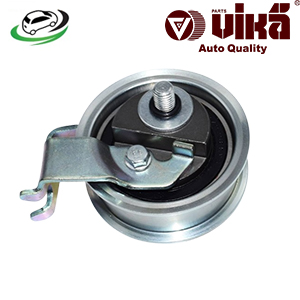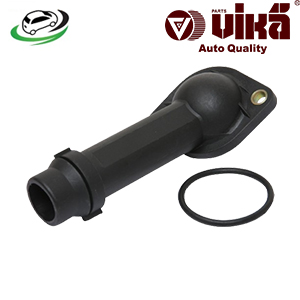-20%
Get Thermostat Housing AUDI A4/ A4 Base/B5/ A4 Quattro Base / VW Passat Base/ Passat For models with ATW/AUG engine code 06B121121L
The thermostat housing is a vital component in an engine’s cooling system, designed to house the thermostat and facilitate the flow of coolant through the engine and radiator. By managing the engine’s operating temperature, the thermostat housing plays a crucial role in maintaining optimal engine performance, fuel efficiency, and emissions control. Understanding its design, functionality, importance, and maintenance can help in keeping the engine running smoothly and avoiding potential overheating issues.
1. Design and Structure
The thermostat housing is typically made from durable materials such as aluminum, plastic, or composite materials. Its primary function is to encase the thermostat and connect various coolant passages within the engine. The key components of the thermostat housing include:
- Housing Body: The main structure of the thermostat housing, which encases the thermostat and directs coolant flow. It is designed to withstand high temperatures and pressures within the engine’s cooling system.
- Thermostat Mounting: An internal section or chamber where the thermostat is installed. The mounting area ensures that the thermostat is correctly positioned and sealed to prevent leaks.
- Coolant Inlet and Outlet Ports: The housing features inlet and outlet ports for coolant flow. These ports connect to the engine’s coolant passages and the radiator, allowing coolant to circulate through the engine and dissipate heat.
- Gasket or Seal: A gasket or seal is used to create a tight seal between the thermostat housing and the engine. This prevents coolant leaks and maintains the integrity of the cooling system.
- Temperature Sensor Port: Some thermostat housings include a port for a temperature sensor that monitors the coolant temperature and provides data to the engine control unit (ECU) for optimal engine management.
2. Functionality
The thermostat housing performs several critical functions in the engine’s cooling system:
- Houses the Thermostat: The thermostat is a temperature-sensitive valve that regulates the flow of coolant between the engine and the radiator. It opens and closes based on the engine’s temperature to maintain an optimal operating temperature.
- Directs Coolant Flow: The housing directs the flow of coolant from the engine to the thermostat and then to the radiator or back to the engine, depending on the thermostat’s position. This ensures that the engine remains at the proper temperature for efficient operation.
- Prevents Leaks: The gasket or seal between the thermostat housing and the engine prevents coolant leaks, maintaining the pressure and integrity of the cooling system.
- Provides Temperature Monitoring: In some designs, the thermostat housing includes a port for a temperature sensor that monitors the coolant temperature. This data is used by the ECU to adjust engine parameters and optimize performance.
3. Importance in Engine Operation
The thermostat housing is crucial for several reasons:
- Maintains Optimal Engine Temperature: The thermostat controls the flow of coolant based on the engine’s temperature, ensuring that the engine operates within its optimal temperature range. Proper temperature management is essential for engine performance, fuel efficiency, and emissions control.
- Prevents Overheating: By regulating the flow of coolant, the thermostat housing helps prevent engine overheating. Overheating can cause severe engine damage, including warped cylinder heads, damaged gaskets, and seized pistons.
- Ensures Efficient Cooling: Proper coolant flow is essential for effective heat dissipation. The thermostat housing helps ensure that coolant circulates efficiently through the engine and radiator, maintaining proper cooling and preventing hot spots.
- Reduces Engine Wear: Operating the engine at the correct temperature reduces wear and tear on engine components. The thermostat housing helps maintain this temperature, contributing to engine longevity and reliability.
4. Types of Thermostat Housings
There are several types of thermostat housings, each designed for specific applications and engine configurations:
- Standard Thermostat Housing: The most common type, designed to house a single thermostat and connect the engine to the radiator. It is typically used in standard passenger vehicles.
- Dual Thermostat Housing: Some engines use dual thermostat housings, which house two thermostats for more precise temperature control. This setup is often found in high-performance or heavy-duty engines.
- Integrated Thermostat Housing: In some modern engines, the thermostat housing is integrated with other components, such as the water pump or temperature sensor. This design simplifies the cooling system and reduces the number of separate components.
- Adjustable Thermostat Housing: Some aftermarket thermostat housings offer adjustable features, allowing for fine-tuning of the coolant flow and temperature regulation. These are often used in performance or racing applications.
5. Common Issues and Maintenance
While thermostat housings are generally durable, they can encounter issues that affect their performance. Common problems include:
- Coolant Leaks: Leaks around the thermostat housing can occur due to a faulty gasket or seal, or due to cracks or damage to the housing itself. Coolant leaks can lead to overheating and engine damage.
- Thermostat Failure: A malfunctioning thermostat can cause incorrect coolant flow, leading to overheating or inadequate engine heating. This can affect engine performance and fuel efficiency.
- Cracks and Damage: The thermostat housing can develop cracks or other damage due to heat and pressure fluctuations. Damaged housings can cause coolant leaks and affect the cooling system’s efficiency.
- Clogging: Over time, debris and sediment can clog the coolant passages within the thermostat housing, affecting coolant flow and temperature regulation.
Maintenance Tips:
- Regular Inspection: Periodically inspect the thermostat housing for signs of leaks, cracks, or damage. Check the gasket or seal for wear and replace it if necessary.
- Check Coolant Levels: Regularly check the coolant levels in the engine and ensure that they are at the recommended level. Low coolant levels can indicate a leak in the thermostat housing or elsewhere in the cooling system.
- Replace the Thermostat: If the thermostat shows signs of malfunction, such as sticking open or closed, replace it promptly. A malfunctioning thermostat can affect engine temperature regulation and performance.
- Flush the Cooling System: Regularly flush the cooling system to remove debris and sediment that can clog the thermostat housing and affect coolant flow.
- Ensure Proper Installation: When installing a new thermostat housing, ensure that it is properly aligned and sealed. Follow the manufacturer’s instructions for installation and tightening of bolts.
6. Replacement and Installation
Replacing the thermostat housing requires careful attention to ensure proper installation and function:
- Locate the Thermostat Housing: Find the thermostat housing in the engine compartment. It is usually located near the engine’s front or side and connected to the coolant lines.
- Drain the Coolant: Before removing the thermostat housing, drain the coolant from the engine to prevent spills and allow for a clean replacement. Use a suitable container to catch the coolant.
- Remove the Old Housing: Disconnect the coolant lines from the thermostat housing. Remove any bolts or fasteners securing the housing in place. Carefully remove the old thermostat housing and any associated gaskets or seals.
- Install the New Housing: Position the new thermostat housing in place and secure it with the appropriate bolts or fasteners. Ensure that any gaskets or seals are properly aligned and in good condition.
- Reconnect the Coolant Lines: Reattach the coolant lines to the new thermostat housing. Ensure that all connections are secure and free of leaks.
- Refill the Coolant: Refill the engine with the recommended type and amount of coolant. Bleed the cooling system to remove any air pockets and ensure proper coolant flow.
- Check for Leaks: Start the engine and check for any signs of coolant leaks around the thermostat housing. Ensure that the cooling system is functioning correctly and that the engine reaches the proper operating temperature.
7. Performance and Aftermarket Options
For those seeking enhanced performance or specific features, there are aftermarket thermostat housings available:
- High-Performance Housings: Aftermarket high-performance thermostat housings offer improved durability and cooling efficiency, suitable for high-performance or racing applications.
- Durable Materials: Some aftermarket housings use advanced materials for better resistance to heat, pressure, and corrosion, extending the lifespan of the housing.
- Integrated Solutions: Some aftermarket options integrate additional components, such as temperature sensors or water pumps, for a more streamlined cooling system.
Follow us on Facebook for more parts.



